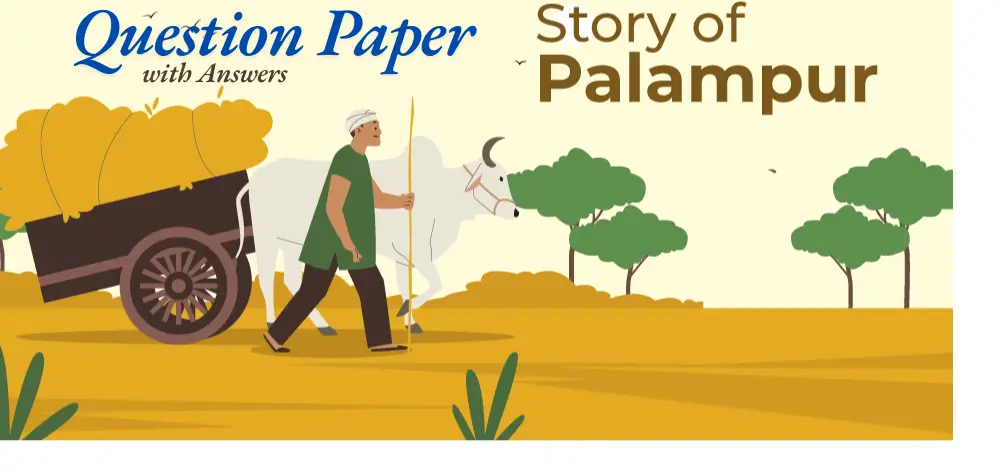Section A: Multiple Choice Questions (1×10 = 10 marks)
-
Which crop is grown in Palampur during the monsoon season?
a) Wheat
b) Jowar and Bajra
c) Potatoes
d) Sugarcane -
How many primary schools are there in Palampur?
a) 3
b) 1
c) 2
d) 4 -
What is the main ingredient in HYV seeds to produce more grains?
a) Less water
b) Extra fertilizer and pesticides
c) Chemical-free soil
d) Traditional farming -
What connects Palampur to the nearby village Raiganj?
a) Railway line
b) Dirt road
c) Pucca road
d) River -
What is not a factor of production?
a) Land
b) Labour
c) Transport
d) Physical Capital -
How much land do small farmers in Palampur usually own?
a) More than 10 hectares
b) Less than 2 hectares
c) Exactly 5 hectares
d) None -
The Green Revolution was first seen in which Indian states?
a) Punjab and Haryana
b) Bihar and UP
c) Rajasthan and Gujarat
d) Tamil Nadu and Kerala -
What kind of capital are tractors and machines?
a) Human
b) Working
c) Fixed
d) Natural -
What is the interest rate usually charged to small farmers in Palampur?
a) 5%
b) 10%
c) 24%
d) 15% -
Who opened a computer center in Palampur?
a) Mishrilal
b) Kareem
c) Ram Singh
d) Lal Singh
Section B: Very Short Answer Questions (2×5 = 10 marks)
-
Name the four factors of production.
-
What is working capital?
-
What was the yield difference between traditional and HYV seeds in Palampur?
-
Mention two non-farm activities in Palampur.
-
Why are small farmers forced to borrow money?
Section C: Assertion and Reasoning (2×5 = 10 marks)
Choose the correct option:
-
a) Both Assertion and Reason are true and Reason is the correct explanation.
-
b) Both Assertion and Reason are true but Reason is not the correct explanation.
-
c) Assertion is true but Reason is false.
-
d) Assertion is false but Reason is true.
Assertion (A): Most Dalit families in Palampur are landless.
Reason (R): They own more than 10 hectares of land.
Assertion (A): Electricity helped farmers irrigate land effectively.
Reason (R): Electric tube-wells are more efficient than traditional irrigation methods.
Assertion (A): The Green Revolution increased the fertility of soil.
Reason (R): The overuse of fertilizers and pesticides enriched the soil.
Assertion (A): HYV seeds require more water.
Reason (R): HYV seeds grow only in deserts.
Assertion (A): Jaggery made in Palampur was sold in Shahpur.
Reason (R): There was no demand for jaggery in Palampur.
Section D: Short Answer Questions (3×5 = 15 marks)
-
Explain two problems caused by the Green Revolution.
-
What are the differences between fixed capital and working capital? Give one example of each.
-
How does multi-cropping help farmers in Palampur?
-
Describe the condition of land distribution in Palampur.
-
How does modern farming depend on industry?
Section E: Long Answer Questions (5×5 = 25 marks)
-
Describe the main features of farming in Palampur.
-
How do non-farm activities help villagers of Palampur earn a living? Explain with examples.
-
Describe the role of human capital in the production process.
-
Explain the importance of land as a factor of production with reference to Palampur.
-
How did the Green Revolution help improve crop production in Palampur? Discuss its benefits and drawbacks.
Answer Key
Section A: MCQs
-
b
-
c
-
b
-
c
-
c
-
b
-
a
-
c
-
c
-
b
Section B: Very Short Answers
11. Land, Labour, Physical Capital, Human Capital
12. Raw materials and money needed for daily use in farming or production.
13. Traditional: 1300 kg/ha; HYV: 3200 kg/ha
14. Dairy and manufacturing (jaggery production)
15. Because they don’t have enough money and need to buy seeds, fertilizers, etc.
Section C: Assertion & Reason
16. c
17. a
18. d
19. c
20. b
Section D: Short Answers
21. Soil fertility loss, groundwater depletion
22. Fixed: Long-term (e.g., tractor), Working: Short-term (e.g., seeds, money)
23. It increases output using the same land by growing multiple crops in a year.
24. 150 Dalit families are landless; 240 families own <2 ha; few have >10 ha.
25. Fertilizers, machinery, and irrigation pumps used in farming are made in factories.
Section E: Long Answers
26. 75% people depend on farming, land used fully, multi-cropping common, HYV seeds used.
27. Dairy, manufacturing (jaggery), transport, and services like computer classes provide income.
28. Human capital brings knowledge, skill, creativity, and direction to production.
29. Without land, farming isn’t possible. It includes natural resources like water and trees.
30. HYV increased yields; but high water, fertilizers, and pesticides caused long-term harm.
Class 9th – Test Paper – The Story of Village Palampur – Question with Answers by The Busy Brains






